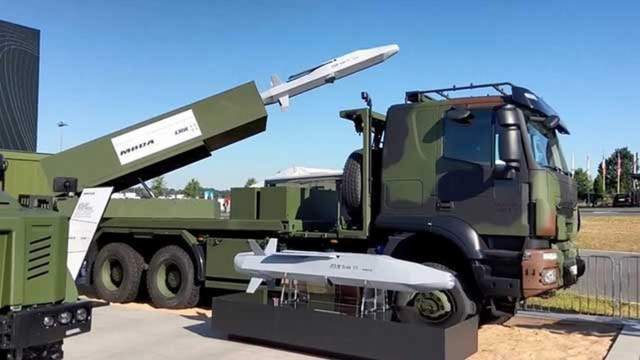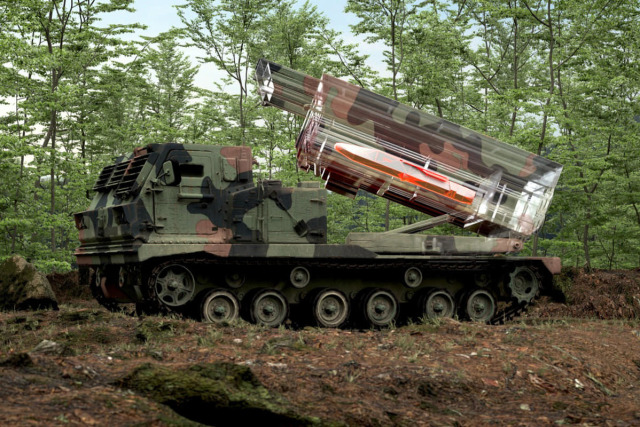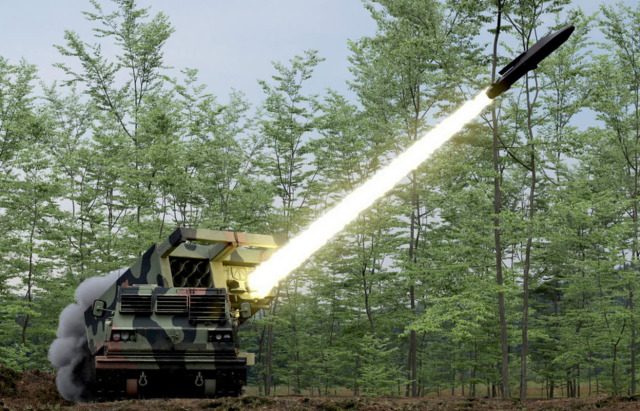As noted in the first part, MBDA Deutschland presented a new concept of a missile system for Joint Tactical fire Support (JFS-M) at the Eurosatory 2022 international weapons exhibition. After the presented justification of a promising system and a design decision in favor of a guided missile (SD), we will proceed to consider the design features of the JFS-M.
Propulsion and navigation systems JFS-M
A combination of a launch accelerator and a turbojet engine already in operation is proposed as the JFS-M propulsion system. It is believed that the accelerator will make it possible to realize the possibilities of zero launch and rocket ejection, for example, from the launcher before the main engine is started.
The JFS-M should develop a variable cruising speed in the subsonic range (min 0.4 – max 0.9 Mach). To make it difficult for enemy sensors to detect UR, its structural elements, communication equipment and drive are designed with the lowest level of radiation. In addition, a significant contribution to the high survivability and success of the JFS-M mission should be made by low infrared and radar visibility in combination with a terrain-adapted flight path (contour and low-altitude flight).
To maintain the flight route even in areas with active counteraction by means of enemy electronic warfare and high-precision destruction of moving targets, the JFS-M is planned to be equipped with a modern navigation system. We are talking about navigation technologies that have been tested for decades in other missile systems and have been further developed, which has made them much more reliable and powerful. Additionally, it is planned to raise the overall navigation performance to a new level by using solutions based on satellite navigation systems (GNSS) complete with alternative sensors for environments with GNSS signal disturbances. It is believed that this will ensure high accuracy of the ammunition, despite protective measures in the electronic spectrum.

Exposition of the JFS-M system layout at Eurosatory 2022Payload and mission planning
As reported, the main requirement of the Bundeswehr CB for a "promising long-range indirect fire system" is an effective, scalable and accurate impact on the target. In accordance with this, it is planned to develop various forms of combat units (warheads) as the main payload for the JFS-M.
In addition to the high-explosive warhead, the missile is likely to receive submunitions or a multi-purpose charge. The technologies needed to scale high-explosive warheads are already undergoing internal testing at the MBDA subsidiary specializing in defense technical systems (TDW Gesellschaft für verteidigungstechnische Wirksysteme mbH).
It is argued that such variants of the warhead will ensure the effect of a scaled impact on the target, corresponding to the specific needs of the combat situation. The latter will give two operational advantages. Firstly, it will minimize unwanted collateral damage. Secondly, if necessary, it will be possible to continue to achieve the desired effect point-by-point. This will make it possible to purposefully fight against fortified structures or heavily armored vehicles in dense urban areas.
Communication with the architecture of combat command and control of troops is planned to be carried out through modern encrypted data transmission channels. It seems that this approach will not only solve the tasks of updating (changing) and interrupting the mission, but will also create new opportunities for the missile complex. So, in addition to the primary use of the JFS-M as a means of destruction, the missile will also be able to be used as a carrier for reconnaissance sensors or electronic warfare.
According to MBDA, along with payload options and combat use scenarios through the mission planning functionality, the company's new intelligent development will provide additional operational advantages to artillery. In particular, a complex combination of mission planning and a combat command and control network can be used not only to accurately determine the trajectory of an approach to a target, but also to identify potential attack targets during overflight or overflight. This will allow you to verify future targets or receive additional intelligence information along the route.
It is expected that the JFS-M will also make it possible to use fire modes that were not previously associated with rocket artillery, namely: "simultaneous attack with multiple missiles" (Multiple Missile Simultaneous Impact) or "Time over Target" (Time over Target). For example, the following options are being considered for using one launcher (PU): simultaneous defeat by several of its missiles of one target or several targets at the same time. Additionally, it is planned to implement the option of simultaneous firing of ballistic and SD from the same PU. It is reported that MBDA is studying the reality of such integration into existing PU. In addition, the company intends to demonstrate the launch of a rocket from wheeled, trailed or offshore platforms. The rocket engine allows it to be used much more flexibly than is possible with ballistic systems.
According to MBDA, automatic target recognition on the final section of the trajectory is also being investigated. In the field, this innovation will allow the operator to make decisions faster. Thanks to the rocket sensors combined with automatic target recognition based on artificial intelligence, the JFS-M could independently conduct reconnaissance in the target area and perform threat analysis, then immediately perform a combat approach at the operator's command. From the point of view of MBDA specialists, in the future a person should maintain control and make a final decision on the use of ammunition in accordance with the current rules of engagement.
Cooperation and prospects for implementation
MBDA, Krauss-Maffei Wegmann (KMW) and ESG Elektroniksystem und Logistik GmbH signed a memorandum of understanding concerning cooperation within the framework of the future "fire system from closed positions" of the Bundeswehr. The aim of the collaboration is to further expand and implement the JFS-M concept, as well as its integration with various platforms. First of all, we are talking about the KMW system platforms (MARS II/MLRS-E) already in service with the Bundeswehr, as well as possible platforms for a "promising long-range indirect fire system." At the same time, it implies a close integration of the JFS-M with the ADLER III ESG artillery combat control system operating in the Bundeswehr.

Integration of JFS-M with the KMW platformMBDA, KMW and ESG consider this memorandum as a starting point for the joint formation of the future of German artillery.
Additionally, they declare their readiness to expand cooperation with other partners who want to share their experience and technologies.
MBDA representatives proceed from the fact that the first technological evidence of the reality of the JFS-M can be obtained already based on the results of a demonstration flight planned for the coming years, parallel to the development project. The company is optimistic that the development period can be adapted to the schedules of the corresponding phase documents of the "Promising Long-range Indirect Fire System".
Thus, in its JFS-M project, MBDA Deutschland GmbH presents a weapon concept that meets the modern requirements of the German Armed Forces for a promising long-range weapon. Theoretically, the declared parameters of the new SD can significantly increase the firepower and qualitatively change the operational capabilities of the German artillery, up to the provision of Air Force support.
According to the materials of the resource soldat-und-technik.de

